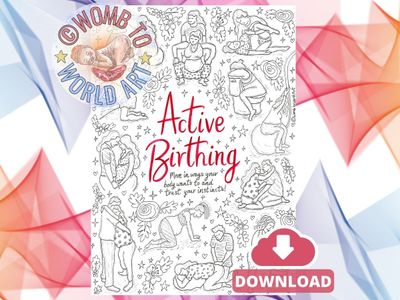Postdates Pregnancy Affirmation A4 Poster
Download an A4 digital poster print featuring a full term baby in the womb with the affirmation 'My baby knows when to be born'.
Over 40 weeks and getting pressure for an induction? Here's some notes I made to help with any discussions with caregivers about the 'risks' of my own 'prolonged' pregnancy.
- Sara Wickham, evidence-based midwife and birth educator, states in her AIMS book on inductions that there is no evidence that placenta deteriation is related to length of pregnancy.
- Sara Wickham also states that scans can predict a date too early or too late due to variations in growth rates.
- World Health Organisation (2011) guidelines acknowledge that the evidence for routine induction at 41 weeks is low quality, and the strength of the evidence is weak.
- Sara Wickham references a 1999 study (Cotzias et al) which shows the risk of unexplained stillbirth at 42 weeks (1 in 769) was actually *less* than at 38 weeks (1 in 730). Yet 38 weeks is considered a normal and healthy time to have a baby.
- The Hannah 1992 trial, which suggested that induction to avoid prolonged pregnancy may be associated with fewer perinatal deaths, has been questioned as flawed - and as such not included in 2008 NICE guidance or 2013 update.
- Sara Wickham warns that monitoring after 42 weeks is not totally accurate and is an area where more research is needed. Because the majority of women are induced before this point, we know very little about what normal volume of fluid (or other things) should be at this stage.
- Dr Rachel Reed, author of 'Why Induction Matters', warns that the idea of a 'prolonged pregnancy' assumes we all gestate our babies for the same length of time, but there is evidence to suggest genetics and factors such as diet affect normal gestation times for individual women (midwifethinking.com)
- Dr Rachel Reed also agrees that there is no evidence to support the theory that the placenta starts to shut down after 42 weeks, or that the skull will calcify and make birth difficult.
- Although a Cochrane review summarises that induction at 41 weeks resulted in fewer perinatal deaths, it states that the absolute risks are extremely small with either policy. Ref 'Induction for labour for improving birth outcomes at or beyond term'.
____________________________
Copyright and Limited Use Commercial License
The limited use commercial license that comes with this download means that birth workers, doulas, hypnobirthing teachers, prenatal yoga teachers, antenatal educators and midwives can print to share and use with pregnant women, birth partners and clients. By buying this download you are agreeing to the following terms:
The license means you - as an individual - can:
- Print the downloads on paper or card at the size specified
- Give the printouts as handouts to your clients, or use as teaching tools or posters for your business
- You may use use a professional print service or print at home
- Add the images to a Powerpoint presentation to use with clients in person or remotely, as long as the presentation file itself isn't shared digitally
- Share the content using photos or videos of your printed materials on social media
The license DOES NOT allow you to:
- Print the images for any other reason than above or on any other material e.g. on a notebook or mug to give away
- Use the images as part of a product you will sell
- Share the digital files with anyone by email or another method
- Add the digital files to your website or use on social media
- Edit the images or remove my brand name
- Share with other professionals in your organisation
Thank you for respecting the time that has gone into creating this artwork. If you have any questions about the license agreement, please contact me.
Copyright
These handmade images, text and files are copyright of Hannah Thomas of Womb to World Art and sole copyright is retained by them.
Disclaimer: Please note my images are stylised visual representations, and the information is accurate to the best of my knowledge, but I am not a medical professional and therefore there may be words or parts of the drawings that aren't 100% anatomically and medically accurate. My materials are not intended to replace any medical caregiver advice.







